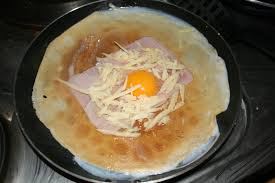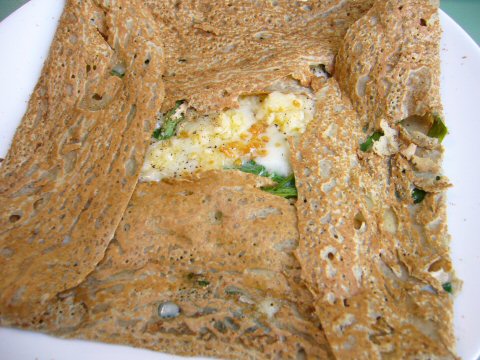One of my favorite discoveries of late, this savory version of a crêpe is gluten- and grain free, and it certainly hits the spot when I’m craving some Old World flavors. Buckwheat has a nutty, earthy taste that is perfect for a savory filling, but will also work with some dark chocolate and bananas (just saying).
Galettes stem from the Brittany region of France. As a bread alternative, they were baked right on top of a hot, flat stone, the jalet, and topped with fresh, simple ingredients. Back in the Middle Ages, peasants loved buckwheat because, as a gluten-free grain (lacking the glue-like component that’s needed for rising), it was not suitable for bread-making and therefore not taxable. While this loophole no longer exists, galettes have stuck around because they are easy to make, versatile and delicious.
At my house, they are enjoying a comeback as a healthy, gluten-free alternative to traditional crêpes, bread or tortillas. It doesn’t hurt that buckwheat is also high in essential minerals and fiber, satiating, blood-sugar balancing and packed with phytonutrients. Those of you on a grain-free diet have even more reason to like it: Despite its name, buckwheat is not a cereal grain at all, but rather a fruit seed, related to rhubarb and sorrel. So what are you waiting for? Try this simple dish, experiment with your favorite fillings, and DIG IN!
Takes: 5 minutes to prep, 30 minutes or overnight to rest, 20 minutes to cook
Makes: 12-14 galettes
Ingredients
- 1 ¼ cups buckwheat flour* **

- 1 teaspoon full mineral salt (I like pink Himalayan)
- 3 large eggs
- 1 cup milk: pastured dairy or homemade unsweetened almond
- 2 tablespoons melted unsalted butter
- ¾ to 1 cup filtered water (I use closer to 1 cup)
* Make sure the package has the GF label, if you are gluten free, otherwise there is a good chance that it’s been cross-contaminated during processing
** You can also use chickpea flour (lighter in color; more protein) or teff flour (nuttier), or a mix of those. My current favorite is a 50-50 mix of buckwheat and chickpea, since it’s got that dark buckwheat flavor, but a lighter, more pliable texture (s. image above).
Instructions
- Whisk all the ingredients except water in a bowl until smooth.
- Let sit covered at room temperature for 30 to 40 minutes, or overnight in the fridge (if so, bring to room temperature before cooking).
- When you are ready to make galettes, thin the batter with water, until you get the consistency of heavy cream.
- Heat a skillet to medium heat. Use a ladle or measuring cup to pour in the batter. I like to pour ca. ¼ cup into one half of the pan at one time, swirl the pan for an even coating, and then add a little more to cover the rest of the pan. Use the measuring cup or a spoon to help spread and to fill holes if necessary.
- Cook the galette for 1 to 2 minutes, until you see little bubbles in the center, the edges are golden, and it lifts from the pan easily. Flip it over and cook it for another minute on the other side.
- Slide the cooked galette onto a plate and repeat the process. I recommend keeping the crêpes in a pre-heated warm oven, stacked and covered with a paper towel, until you are ready to fill and eat them.
Serving and filling suggestions:
In the Brittany region of France, the most popular galette is the so-called ‘complète’: filled with ham, cheese and a sunny side up egg. They usually place grated cheese, ham, fresh herbs and a cracked egg into the center of the pan as soon as the batter is no longer wet and runny-looking. Then they fold over the edges of the crepe on 4 sides, cover it with a lid, and finish cooking it right in the pan. However, I like to just put a fried egg on top of my cooked ham and melty cheese galette. That way I know my egg is done just how I like it.
If this sounds too involved for you, you could simply place some shredded gruyere cheese and a slice of Black Forest ham on one half of a cooked galette, then fold it in half, and fold it in half again. Wrapped in a paper towel, this is the perfect finger food.
Other fillings I am in love with: A creamy mushroom ragout with fresh parsley; leftover chicken fajita filling (yes, really); skyr/yogurt, preserves and fresh fruit; bananas, honey and almond butter; rum-laced chestnut cream; a citrus and butter sauce (à la Suzette); garlicky creamed spinach and pecorino; sundried tomato and olive tapenade with goat cheese … Yum! If you’ll excuse me, I better start whipping up some batter now.
Tips and Troubleshooting
If you don’t have time to rest the batter, mix it in a high-speed blender or stand mixer instead. It’s hard to overwork buckwheat batter, and the agitation will make for a more pliable galette.
If you like more of a buttery flavor, you can grease the pan with ½ Tbsp of pastured butter or ghee and add more butter to the pan as needed. I like to cook my galettes in a dry pan.
My grandmother swears by adding mineral water instead of tap water, for a lighter consistency.
If the first crepe will not cover the bottom of the pan and/or seizes up instead of spreading evenly, we’re usually dealing with one of these two issues: a) Your batter is still too thick. Add a little more water or milk and try again. b) Your stovetop is too hot. Turn down the heat to a 3 out of 10 and try again. Your pan should be hot enough that the batter colors within one minute, but not so hot that the batter sets before you have time to let it run over the entire pan. As a rule, though, the first crepe never turns out pretty or perfect. Relax, and munch on this ugly duckling while you find your rhythm.
If you have more batter than you and yours can use up at one time, you can put the rest back in the fridge and make fresh galettes the next day. Or, you could cook all the galettes and use them later. I really like rolling them up and slicing them thinly to form noodles. These are wonderful in a hearty chicken soup or beef broth. Both the galettes and the galette noodles (we call them ‘frittaten’ where I’m from) can be frozen, wrapped airtight, for up to 3 months.

Dietary restrictions: If you are on an autoimmune protocol, I recommend eliminating, then challenging buckwheat, to see if your body tolerates it. Eggs are traditionally not necessary in the batter, they just help bind it. Use the blender method if you are omitting eggs. If you avoid dairy, use almond milk in the batter and choose a non-dairy filling. To make this crepe vegan, fill it with sauteed veggies and herbed cashew spread.

